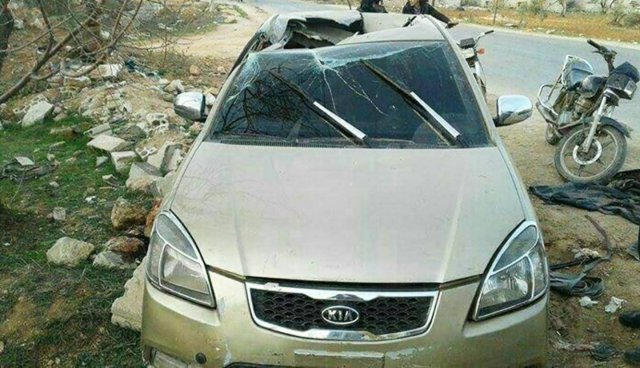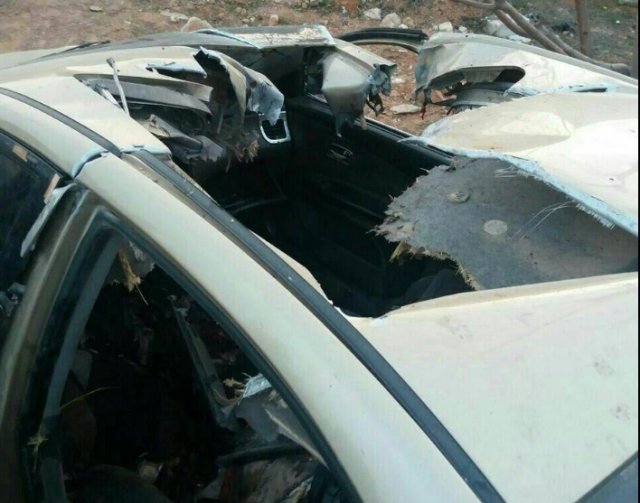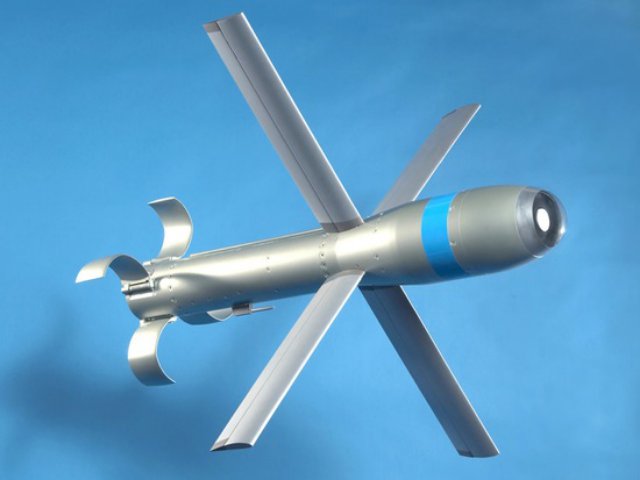In one sense the death of Abu al-Khayr al-Masri is no mystery. The Pentagon has acknowledged that it carried out a drone strike near Idlib in Syria which killed Al-Masri, who was described as “a core al-Qaida leader” on February 4. However, this was very different to the usual attacks carried out by unmanned aircraft.
Evidence from the site indicates that a highly unusual new weapon was used, and some detective work is needed to identify the mystery missile. The MQ-9 Reaper drone currently carries two types of weapon: AGM-114 Hellfire missiles and 500-pound guided bombs. The Hellfire is by far the smaller of the two, but its twenty-pound high-explosive warhead was originally designed to take out heavy tanks. A hit will reduce a car or pickup truck to a burned-out skeleton, as seen by the remnants left after this strike in Yemen, this one in Pakistan or this one in Afghanistan. By contrast, pictures show that the damage to al-Masri’s car, a small Kia, was minimal. There is a large hole in the roof, the windscreen is damaged but intact, and the side windows are still in place.  Clearly, a less powerful weapon was used. A wide range small munitions have been developed for drones, offering lightweight and lower-cost options than Hellfire for use against unarmored targets. These include weapons like the 34-pound AGM-176 Griffin and the APKWS (“Advanced Precision Kill Weapon”), a laser-guided 25-pound rocket now in service in the US military and which can be launched from unmanned aircraft. A whole slew of private developments – ATK’s Hatchet, Raytheon’s Pyros, MDBA’s Saber, Thales Lightweight Multirole Missile, Lockheed Martin’s Shadow Hawk, among others – are also on offer. One of the very smallest new munitions is the Spike missile, a five-pound weapon developed by the US Navy and described as being ‘the size of a baguette’. It has laser and optical guidance, and can be carried by small drones. Spike has been under development for over ten years, and the Navy have kept quiet about it lately, but work has bene progressing. However, images from previous tests show that even the Spike’s one-pound warhead is enough to blow a small vehicle apart. A closer look at al-Masri’s car shows that the hole in the roof was not from a blast inside the car: the edges of the hole curve downwards, suggesting it was the entry point for whatever hit the vehicle. It struck from a high angle, coming down close to vertically. And, as far as we can tell from the fact that no windows were blown out, the damage was caused by kinetic impact alone, with no explosive.
Clearly, a less powerful weapon was used. A wide range small munitions have been developed for drones, offering lightweight and lower-cost options than Hellfire for use against unarmored targets. These include weapons like the 34-pound AGM-176 Griffin and the APKWS (“Advanced Precision Kill Weapon”), a laser-guided 25-pound rocket now in service in the US military and which can be launched from unmanned aircraft. A whole slew of private developments – ATK’s Hatchet, Raytheon’s Pyros, MDBA’s Saber, Thales Lightweight Multirole Missile, Lockheed Martin’s Shadow Hawk, among others – are also on offer. One of the very smallest new munitions is the Spike missile, a five-pound weapon developed by the US Navy and described as being ‘the size of a baguette’. It has laser and optical guidance, and can be carried by small drones. Spike has been under development for over ten years, and the Navy have kept quiet about it lately, but work has bene progressing. However, images from previous tests show that even the Spike’s one-pound warhead is enough to blow a small vehicle apart. A closer look at al-Masri’s car shows that the hole in the roof was not from a blast inside the car: the edges of the hole curve downwards, suggesting it was the entry point for whatever hit the vehicle. It struck from a high angle, coming down close to vertically. And, as far as we can tell from the fact that no windows were blown out, the damage was caused by kinetic impact alone, with no explosive.  “It’s almost as if an anvil was dropped on the car’s occupants,” says Tyler Rogoway in his article for WarZone. Kinetic impact has been used for some time when there is a high risk of collateral damage. In 1999, U.S. warplanes used 2,000-pound bombs filled with concrete rather than explosive against Iraq military targets like air defense sites in populated areas. Clearly something very much smaller than this hit al-Masri’s car. The fact that there was no fire or signs or burn damage suggests that the weapon may not have been a missile or rocket. Rocket fuel burns at very high temperature, which can contribute to the effect on the target – burning propellant may do more damage than the warhead. Even if there was no unexpended fuel, missile exhausts are still extremely hot and one inside a car would likely start a fire. The car also gives us another valuable forensic clue. It was a moving target struck with surgical precision, the hole in the roof mere inches from where al-Masri was sitting. So, putting this together we have a small precision weapon with a kinetic warhead, no rocket motor and with an almost-vertical attack profile. It turns out that there is a weapon which matches this description, developed to take out precisely this type of target. The GBU-44/B Viper Strike, currently supplied to the U.S. military by MBDA, is a forty-four pound gliding munition. (It has a peculiar history, having been developed from a Cold War anti-tank weapon called the BAT or “Brilliant Anti-Tank munition.”) Viper Strike has a ‘glide ratio’ of 1:10, meaning that from an altitude of 5,000 feet or one mile it can hit a target ten miles away. Being unpowered means it is completely silent, and there is no exhaust flare: it is an ideal stealth weapon as it does not draw any attention to the launching platform. A series of videos of test-firings show Viper Strike being used against cars. These also demonstrate the near-vertical angle of attack, designed for ‘reaching down’ into urban canyons and other restricted spaces. Back in 2005, U.S. Army deputy product manager Steve Borden boasted of Viper Strike’s extreme precision to National Defense magazine: “We can drop this between a mosque and a busload of nuns, and not hurt either the mosque or the nuns,” he said. “We can use it to fly through a window and take out a sniper, or hit a car in a convoy.” The standard warhead is a couple of pounds of explosive, but John Miller, then project manager , said Viper Strike could be used as a kinetic weapon: “At one of our [planning] meetings, we were asked a question by the special ops guys, ‘What if I want to kill a vehicle but not the people in it? Can you do that?’ And the answer is yes, since we have a selective warhead, and we can set it not to detonate. So we could take out the engine deck but allow the capture of folks inside the vehicle.” The same option could be used to take out someone inside while leaving the vehicle intact. Army documents indicate that a ‘smart rock’ kinetic option was developed, but there were no subsequent reports that it was acquired or deployed. It may have been quietly retained for special uses. The standard Viper Strike with a conventional warhead is part of the Special Operations Precision Guided Munition program from AC-130W gunships; a small number have been used in action. Although not officially used to arm drones, there were test-launches from unmanned aircraft as far back as 2005 and the Predator/Reaper was considered a likely platform. Why would an unproven weapon be used rather than the trusted Hellfire on a valuable target like al-Masri? Here we are on much less certain ground, but there are at least two possible explanations:
“It’s almost as if an anvil was dropped on the car’s occupants,” says Tyler Rogoway in his article for WarZone. Kinetic impact has been used for some time when there is a high risk of collateral damage. In 1999, U.S. warplanes used 2,000-pound bombs filled with concrete rather than explosive against Iraq military targets like air defense sites in populated areas. Clearly something very much smaller than this hit al-Masri’s car. The fact that there was no fire or signs or burn damage suggests that the weapon may not have been a missile or rocket. Rocket fuel burns at very high temperature, which can contribute to the effect on the target – burning propellant may do more damage than the warhead. Even if there was no unexpended fuel, missile exhausts are still extremely hot and one inside a car would likely start a fire. The car also gives us another valuable forensic clue. It was a moving target struck with surgical precision, the hole in the roof mere inches from where al-Masri was sitting. So, putting this together we have a small precision weapon with a kinetic warhead, no rocket motor and with an almost-vertical attack profile. It turns out that there is a weapon which matches this description, developed to take out precisely this type of target. The GBU-44/B Viper Strike, currently supplied to the U.S. military by MBDA, is a forty-four pound gliding munition. (It has a peculiar history, having been developed from a Cold War anti-tank weapon called the BAT or “Brilliant Anti-Tank munition.”) Viper Strike has a ‘glide ratio’ of 1:10, meaning that from an altitude of 5,000 feet or one mile it can hit a target ten miles away. Being unpowered means it is completely silent, and there is no exhaust flare: it is an ideal stealth weapon as it does not draw any attention to the launching platform. A series of videos of test-firings show Viper Strike being used against cars. These also demonstrate the near-vertical angle of attack, designed for ‘reaching down’ into urban canyons and other restricted spaces. Back in 2005, U.S. Army deputy product manager Steve Borden boasted of Viper Strike’s extreme precision to National Defense magazine: “We can drop this between a mosque and a busload of nuns, and not hurt either the mosque or the nuns,” he said. “We can use it to fly through a window and take out a sniper, or hit a car in a convoy.” The standard warhead is a couple of pounds of explosive, but John Miller, then project manager , said Viper Strike could be used as a kinetic weapon: “At one of our [planning] meetings, we were asked a question by the special ops guys, ‘What if I want to kill a vehicle but not the people in it? Can you do that?’ And the answer is yes, since we have a selective warhead, and we can set it not to detonate. So we could take out the engine deck but allow the capture of folks inside the vehicle.” The same option could be used to take out someone inside while leaving the vehicle intact. Army documents indicate that a ‘smart rock’ kinetic option was developed, but there were no subsequent reports that it was acquired or deployed. It may have been quietly retained for special uses. The standard Viper Strike with a conventional warhead is part of the Special Operations Precision Guided Munition program from AC-130W gunships; a small number have been used in action. Although not officially used to arm drones, there were test-launches from unmanned aircraft as far back as 2005 and the Predator/Reaper was considered a likely platform. Why would an unproven weapon be used rather than the trusted Hellfire on a valuable target like al-Masri? Here we are on much less certain ground, but there are at least two possible explanations:
- As mentioned, Viper Strike is a stealth weapon. There might be little point in putting it on a Reaper, but it would make sense to carry one on a quieter and less visible drone, so it may signal that this strike was carried out by a new type of drone.
- This is a message to the Jihadis. Not only can they be hit anywhere suddenly without warning, but now it can be done with sniper-like precision so that even on a busy street there is little risk of collateral damage. Human shields offer little protection.
Either way the attack suggests that U.S. drone operators are raising their game. Death from above may now come personally addressed. Source: Warrior


Perhaps my age has led to a decline in my eye sight, because what I observed in the video which showed the Viper hitting targets was an explosion, not a kinetic impact? It also appears the strikes were not from above, but from the rear. Taken together it leaves me to conclude that perhaps the strike which took out the terrorist may have been from either another newly developed type of weapon, or from one which failed to explode on impact. I doubt it was the former, because of the time and effort which as taken to track the target, all to risk not killing him because the weapon wasn’t powerful enough.
Love to hear other opinions.
You did not it appears watch the whole video, and also read the whole article. The warhead can be turned off and not detonate, for a kinetic kill scenario. I think at least one was a non-detonation event, either planned or otherwise.
I understand the hunt for information, but this article is ignoring what is likely the simple answer. A hellfire rocket only burns for a few seconds, so at impact from a high flying MQ-9 it would be out of propellant (so no fire from the rocket motor). A hellfire that fails to detonate is still a 100lbs bullet going 500+ mph at impact. I don’t care how hardcore of a terrorist he was, he’s not surviving a direct hit from a missile whether it detonated or not.
Maybe it was a new type of weapon, but it would have to be a really small warhead to not even blow out the front windshield…I vote for a direct hit dud.
Yup – that sounds plausible – Ed.
that is my conclusion as well. Hope they can’t recycle the warhead….